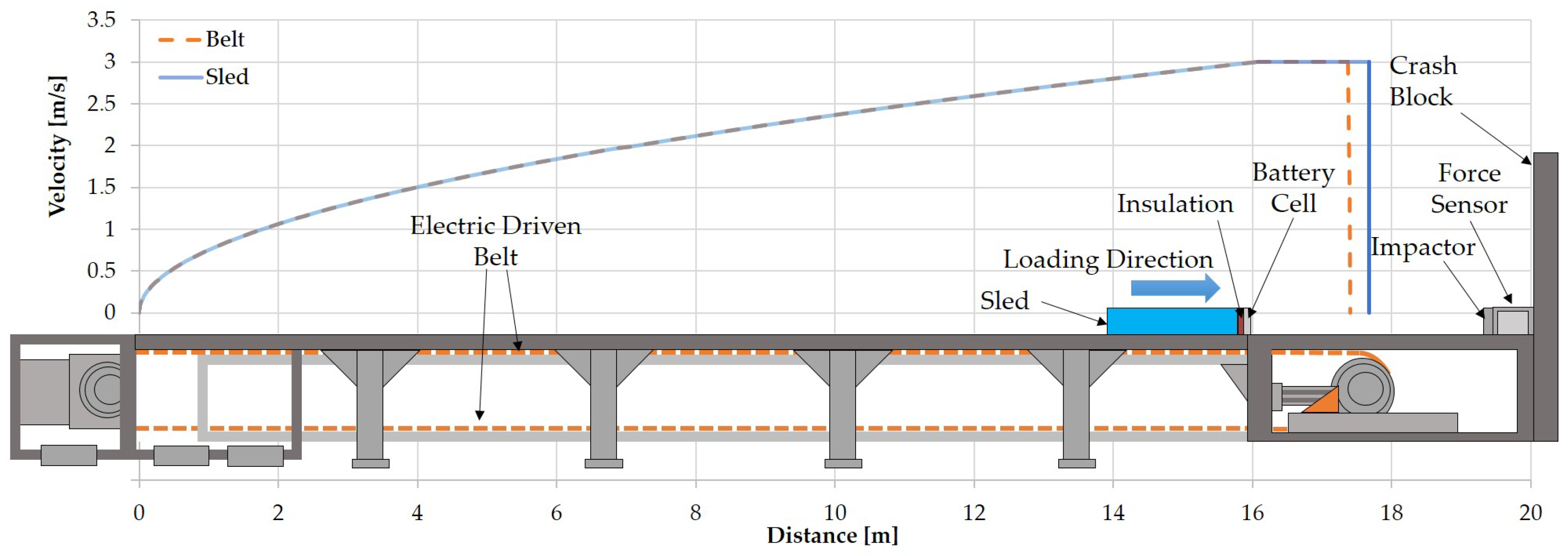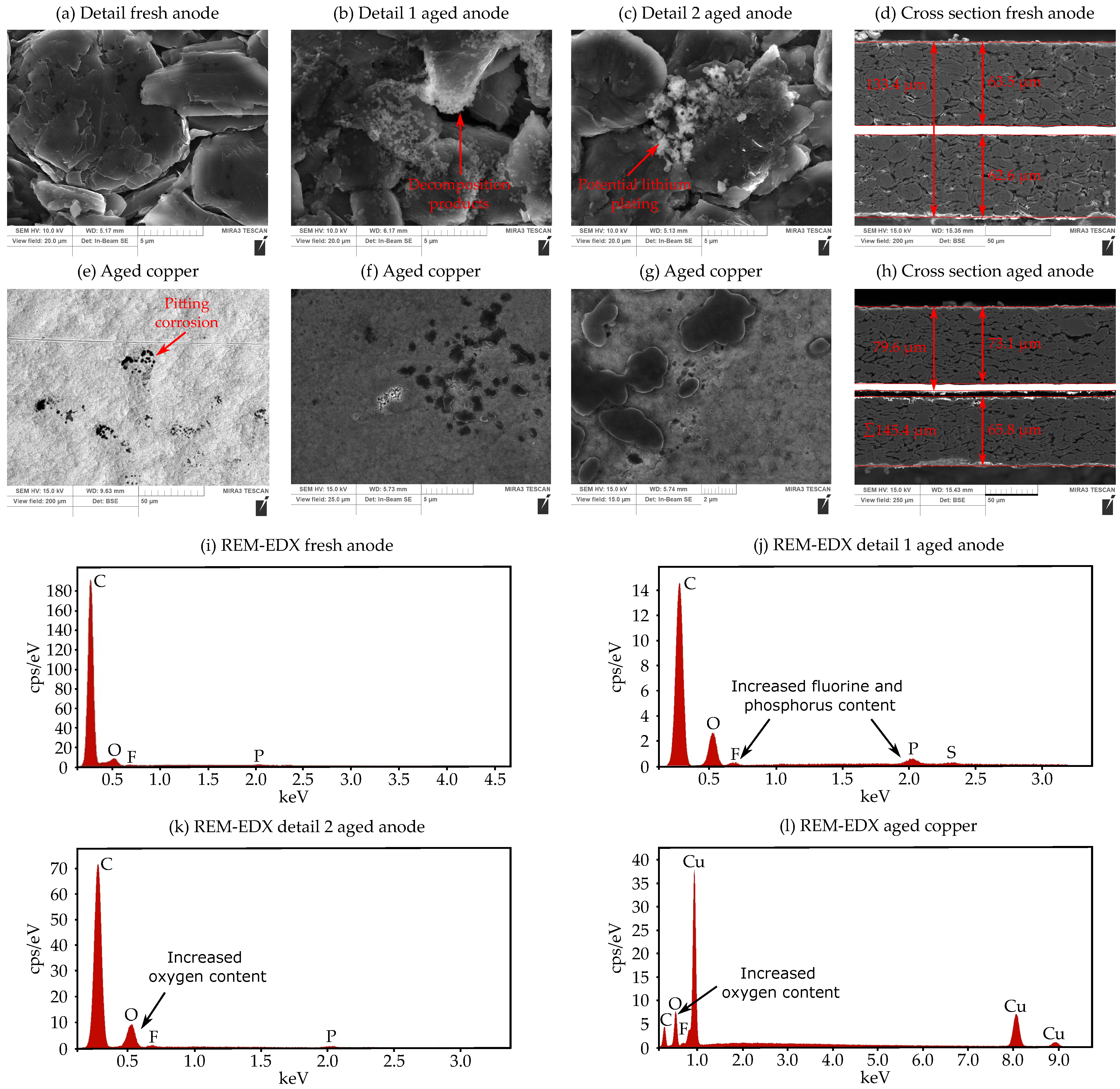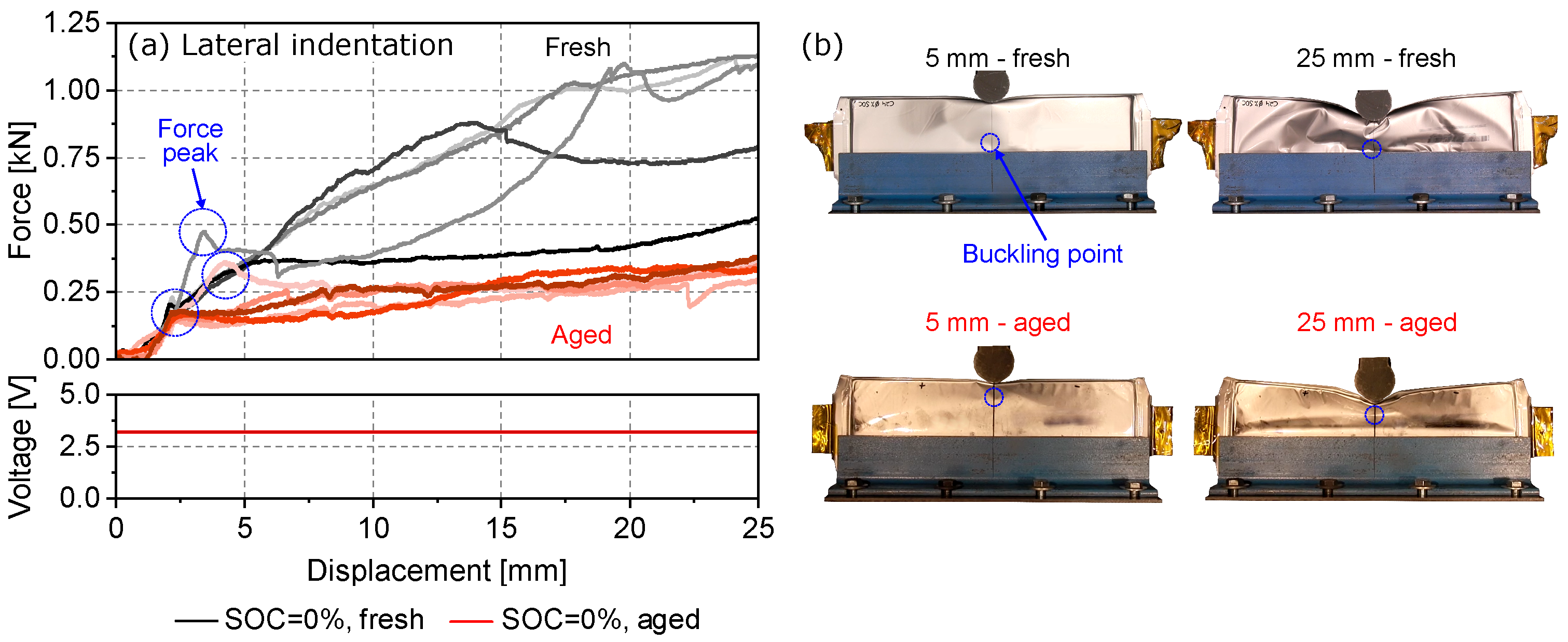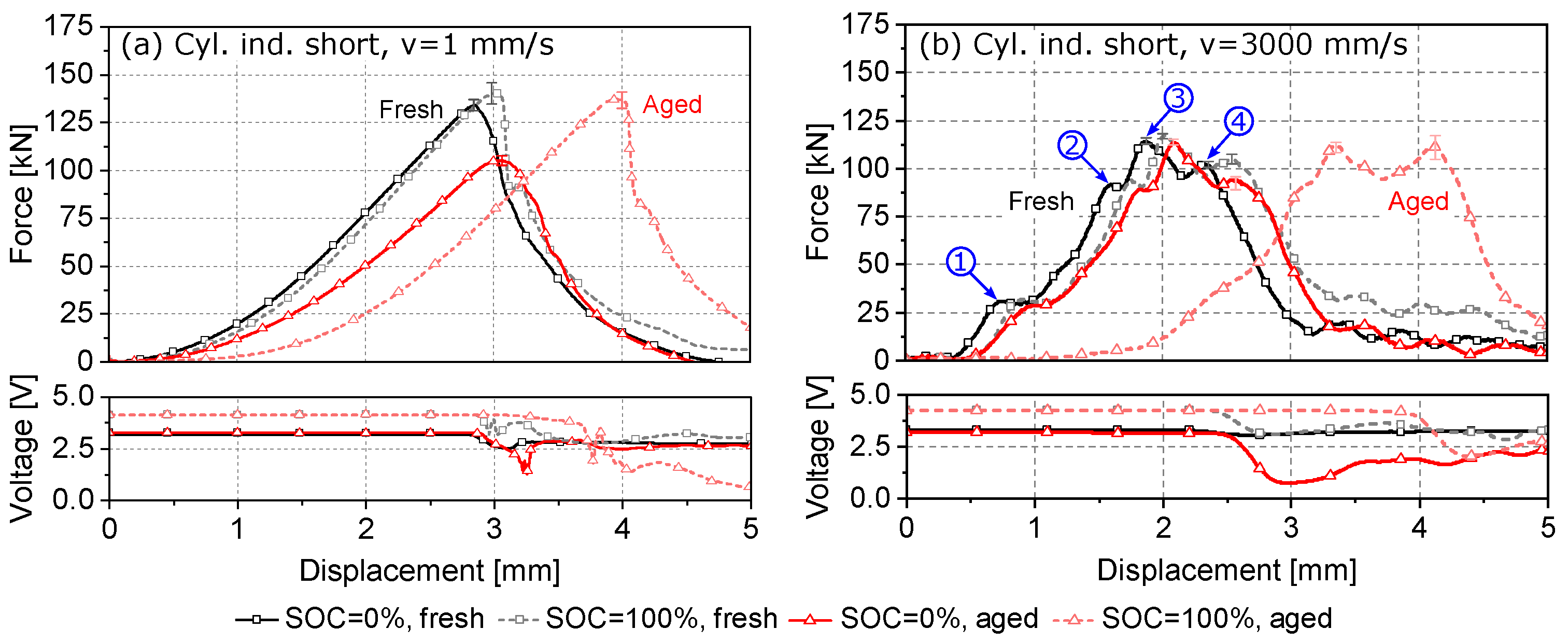Changes in the Mechanical Behavior of Electrically Aged Lithium-Ion Pouch Cells: In-Plane and Out-of-Plane Indentation Loads with Varying Testing Velocity and State of Charge
Abstract
1. Introduction
2. Materials and Methods
2.1. Investigated Lithium-Ion Cell
2.2. Post-Mortem Analysis
2.3. Mechanical Testing
2.3.1. Experimental Design
2.3.2. Quasistatic Testing Device
2.3.3. Dynamic Testing Device
3. Results
3.1. Post-Mortem Analysis
3.2. Lateral Indentation
3.3. Cylindrical Indentation Long Side
3.4. Cylindrical Indentation Short Side
4. Summary and Conclusions
- The investigated aged pouch cells show a right-shifted force-displacement curve, a lower stiffness and deeper voltage drops under mechanical indentation in thickness direction compared to fresh cells. Furthermore, lower failure forces of aged cells can be noticed at 0% SOC.
- The right-shifted force-displacement curve in the thickness direction of the cell is caused by aging effects such as the growth of the SEI layer as well as lithium plating effects. The thickness increase of the anode examined in the SEM measurements correlates with the shift of the force-displacement curve at 0% SOC. This demonstrates electrolyte consumption within the cell, which has a direct influence on the size of the plateaus in the dynamic test.
- Under lateral loading, the fresh cell shows lower buckling stability. The most probable reason for this is the lower mechanical stability of the laminated composite. Aged cells are subjected to higher mechanical pressure in the thickness direction, which compresses the cell interior.
- Regardless of the aging condition, the cell under study shows two significant force drops under dynamic cylindrical indentation, with the former presumably involving failure of only the anode graphite layer and the latter involving failure of the separator.
- The influence of state of charge is similar under quasistatic and dynamic loading. Aged cells show a higher dependence on the state of charge.
- The tensile strength of the aged anode may be reduced by aging effects such as pitting corrosion, as these effects can lead to reduced adhesion between the current collector and the active material.
Author Contributions
Funding
Institutional Review Board Statement
Informed Consent Statement
Data Availability Statement
Acknowledgments
Conflicts of Interest
Abbreviations
| C-Rate | Charging rate |
| DMC | Dimethyl carbonate |
| DoD | Depth of discharge |
| EDX | Energy dispersive X-ray |
| EV | Electric vehicle |
| ICP-OES | Inductively coupled plasma optical emission spectrometry |
| ISC | Internal short circuit |
| LIBs | Lithium-ion batteries |
| NCM | Lithium nickel manganese cobalt oxide |
| SEI | Solid electrolyte interface |
| SEM | Scanning electron microscopy |
| SOC | State of Charge |
| SOH | State of Health |
| TR | Thermal runaway |
References
- Jaguemont, J.; Boulon, L.; Dubé, Y. A comprehensive review of lithium-ion batteries used in hybrid and electric vehicles at cold temperatures. Appl. Energy 2016, 164, 99–114. [Google Scholar] [CrossRef]
- Abaza, A.; Ferrari, S.; Wong, H.K.; Lyness, C.; Moore, A.; Weaving, J.; Blanco-Martin, M.; Dashwood, R.; Bhagat, R. Experimental study of internal and external short circuits of commercial automotive pouch lithium-ion cells. J. Energy Storage 2018, 16, 211–217. [Google Scholar] [CrossRef]
- Yang, R.; Xiong, R.; Ma, S.; Lin, X. Characterization of external short circuit faults in electric vehicle Li-ion battery packs and prediction using artificial neural networks. Appl. Energy 2020, 260, 114253. [Google Scholar] [CrossRef]
- Greve, L.; Fehrenbach, C. Mechanical testing and macro-mechanical finite element simulation of the deformation, fracture, and short circuit initiation of cylindrical Lithium ion battery cells. J. Power Sources 2012, 214, 377–385. [Google Scholar] [CrossRef]
- Sahraei, E.; Campbell, J.; Wierzbicki, T. Modeling and short circuit detection of 18650 Li-ion cells under mechanical abuse conditions. J. Power Sources 2012, 220, 360–372. [Google Scholar] [CrossRef]
- Sahraei, E.; Kahn, M.; Meier, J.; Wierzbicki, T. Modelling of cracks developed in lithium-ion cells under mechanical loading. RSC Adv. 2015, 5, 80369–80380. [Google Scholar] [CrossRef]
- Sahraei, E.; Bosco, E.; Dixon, B.; Lai, B. Microscale failure mechanisms leading to internal short circuit in Li-ion batteries under complex loading scenarios. J. Power Sources 2016, 319, 56–65. [Google Scholar] [CrossRef]
- Xu, J.; Liu, B.; Hu, D. State of charge dependent mechanical integrity behavior of 18650 lithium-ion batteries. Sci. Rep. 2016, 6, 21829. [Google Scholar] [CrossRef]
- Xia, Y.; Chen, G.; Zhou, Q.; Shi, X.; Shi, F. Failure behaviours of 100% SOC lithium-ion battery modules under different impact loading conditions. Eng. Fail. Anal. 2017, 82, 149–160. [Google Scholar] [CrossRef]
- Li, W.; Xia, Y.; Zhu, J.; Luo, H. State-of-Charge Dependence of Mechanical Response of Lithium-Ion Batteries: A Result of Internal Stress. J. Electrochem. Soc. 2018, 165, 1537–1546. [Google Scholar] [CrossRef]
- Tsutsui, W.; Siegmund, T.; Parab, N.; Liao, H.; Nguyen, T.; Chen, W. State-of-Charge and Deformation-Rate Dependent Mechanical Behavior of Electrochemical Cells. Exp. Mech. 2018, 58, 627–632. [Google Scholar] [CrossRef]
- Xu, J.; Liu, B.; Wang, L.; Shang, S. Dynamic mechanical integrity of cylindrical lithium-ion battery cell upon crushing. Eng. Fail. Anal. 2015, 53, 97–110. [Google Scholar] [CrossRef]
- Kisters, T.; Sahraei, E.; Wierzbicki, T. Dynamic impact tests on lithium-ion cells. Int. J. Impact Eng. 2017, 108, 205–216. [Google Scholar] [CrossRef]
- Kisters, T.; Kuder, J.; Töpel, A.; Langkemper, R.; Nau, S.; Schopferer, S. Strain-rate dependence of the failure behavior of Lithium-Ion pouch cells under impact loading. J. Energy Storage 2021, 41, 102901. [Google Scholar] [CrossRef]
- Zhu, J.; Luo, H.; Li, W.; Gao, T.; Xia, Y.; Wierzbicki, T. Mechanism of strengthening of battery resistance under dynamic loading. Int. J. Impact Eng. 2019, 131, 78–84. [Google Scholar] [CrossRef]
- Tancogne-Dejean, T.; Grolleau, V.; Mohr, D. Strain rate dependent plasticity of lithium-ion pouch cells: Experiments and simulations. Int. J. Impact Eng. 2022, 159, 104048. [Google Scholar] [CrossRef]
- Kisters, T.; Keshavarzi, M.; Kuder, J.; Sahraei, E. Effects of electrolyte, thickness, and casing stiffness on the dynamic response of lithium-ion battery cells. Energy Rep. 2021, 7, 6451–6461. [Google Scholar] [CrossRef]
- Raffler, M.; Sinz, W.; Erker, S.; Brunnsteiner, B.; Ellersdorfer, C. Influence of loading rate and out of plane direction dependence on deformation and electro-mechanical failure behavior of a lithium-ion pouch cell. J. Energy Storage 2022, 56, 105906. [Google Scholar] [CrossRef]
- Birkl, C.R.; Roberts, M.R.; McTurk, E.; Bruce, P.G.; Howey, D.A. Degradation diagnostics for lithium ion cells. J. Power Sources 2017, 341, 373–386. [Google Scholar] [CrossRef]
- Xiong, R.; Pan, Y.; Shen, W.; Li, H.; Sun, F. Lithium-ion battery aging mechanisms and diagnosis method for automotive applications: Recent advances and perspectives. Renew. Sustain. Energy Rev. 2020, 131, 110048. [Google Scholar] [CrossRef]
- Xu, J.; Jia, Y.; Liu, B.; Zhao, H.; Yu, H.; Li, J.; Yin, S. Coupling Effect of State-of-Health and State-of-Charge on the Mechanical Integrity of Lithium-Ion Batteries. Exp. Mech. 2018, 58, 633–643. [Google Scholar] [CrossRef]
- Zhang, X.; Zhu, J.; Sahraei, E. Degradation of battery separators under charge–discharge cycles. RSC Adv. 2017, 7, 56099–56107. [Google Scholar] [CrossRef]
- Wu, Z.; Cao, L.; Hartig, J.; Santhanagopalan, S. (Invited) Effect of Aging on Mechanical Properties of Lithium Ion Cell Components. ECS Trans. 2017, 77, 199–208. [Google Scholar] [CrossRef]
- Fink, K.; Santhanagopalan, S.; Hartig, J.; Cao, L. Characterization of Aged Li-Ion Battery Components for Direct Recycling Process Design. J. Electrochem. Soc. 2019, 166, 3775–3783. [Google Scholar] [CrossRef]
- Kovachev, G.; Ellersdorfer, C.; Gstrein, G.; Hanzu, I.; Wilkening, H.M.R.; Werling, T.; Schauwecker, F.; Sinz, W. Safety assessment of electrically cycled cells at high temperatures under mechanical crush loads. eTransportation 2020, 6, 100087. [Google Scholar] [CrossRef]
- Liu, Y.; Xia, Y.; Zhou, Q. Effect of low-temperature aging on the safety performance of lithium-ion pouch cells under mechanical abuse condition: A comprehensive experimental investigation. Energy Storage Mater. 2021, 40, 268–281. [Google Scholar] [CrossRef]
- Sprenger, M.; Dölle, N.; Schauwecker, F.; Raffler, M.; Ellersdorfer, C.; Sinz, W. Multiscale Analysis and Safety Assessment of Fresh and Electrical Aged Lithium-Ion Pouch Cells Focusing on Mechanical Behavior. Energies 2022, 15, 847. [Google Scholar] [CrossRef]
- Liu, Y.; Xia, Y.; Xing, B.; Zhou, Q. Mechanical-electrical-thermal responses of lithium-ion pouch cells under dynamic loading: A comparative study between fresh cells and aged ones. Int. J. Impact Eng. 2022, 166, 104237. [Google Scholar] [CrossRef]
- Preger, Y.; Torres-Castro, L.; Rauhala, T.; Jeevarajan, J. Perspective—On the Safety of Aged Lithium-Ion Batteries. J. Electrochem. Soc. 2022, 169, 030507. [Google Scholar] [CrossRef]
- Dai, S.; Chen, J.; Ren, Y.; Liu, Z.; Chen, J.; Li, C.; Zhang, X.; Zhang, X.; Zeng, T. Electrochemical corrosion behavior of the copper current collector in the electrolyte of lithium-ion batteries. Int. J. Electrochem. Sci. 2017, 12, 10. [Google Scholar] [CrossRef]
- Shin, H.; Park, J.; Han, S.; Sastry, A.M.; Lu, W. Component-/structure-dependent elasticity of solid electrolyte interphase layer in Li-ion batteries: Experimental and computational studies. J. Power Sources 2015, 277, 169–179. [Google Scholar] [CrossRef]
- Sahraei, E.; Meier, J.; Wierzbicki, T. Characterizing and modeling mechanical properties and onset of short circuit for three types of lithium-ion pouch cells. J. Power Sources 2014, 247, 503–516. [Google Scholar] [CrossRef]
- Luo, H.; Xia, Y.; Zhou, Q. Mechanical damage in a lithium-ion pouch cell under indentation loads. J. Power Sources 2017, 357, 61–70. [Google Scholar] [CrossRef]







| Test | SOC [%] | SOH [%] | QS | DYN | v [mm/s] | Load Direction | Investigated Parameter |
|---|---|---|---|---|---|---|---|
| Lateral Indentation | 0 | 90/100 | x | 1 | v | SOH | |
| Cylindrical Indentation Long Side | 0 | 90/100 | x | 1 | w | SOH | |
| Cylindrical Indentation Short Side | 0/100 | 90/100 | x | 1 | w | SOC & SOH [27] | |
| 0/100 | 90/100 | x | 3000 | w | Strain Rate |
| (a) Influence of Testing Velocity | ||||||||||||
| Parameter | ||||||||||||
| QS | DYN | QS | DYN | QS | DYN | QS | DYN | |||||
| S [N/mm] | 66.8 | 104.8 | +57% | 69.3 | 108.7 | +57% | 55.5 | 96.0 | +75% | 60.9 | 87.2 | +43% |
| [mm] | 2.87 | 2.38 | −17% | 3.01 | 2.58 | −14% | 3.04 | 2.55 | −16% | 3.97 | 4.14 | +4% |
| [kN] | 133.9 | 100.3 | −25% | 140.2 | 104.2 | −26% | 104.0 | 93.9 | −10% | 136.9 | 110.1 | −20% |
| (b) Influence of State of Charge | ||||||||||||
| Parameter | ||||||||||||
| Low | High | Low | High | Low | High | Low | High | |||||
| S [N/mm] | 66.8 | 69.3 | +4% | 104.8 | 108.7 | +4% | 55.5 | 60.9 | +10% | 96.0 | 87.2 | −9% |
| [mm] | 2.87 | 3.01 | +5% | 2.38 | 2.58 | +8% | 3.04 | 3.97 | +31% | 2.55 | 4.14 | +62% |
| [kN] | 133.9 | 140.2 | +5% | 100.3 | 104.2 | +4% | 104.0 | 136.9 | +32% | 93.9 | 110.1 | +17% |
| (c) Influence of Aging | ||||||||||||
| Parameter | ||||||||||||
| Fresh | Aged | Fresh | Aged | Fresh | Aged | Fresh | Aged | |||||
| S [N/mm] | 66.8 | 55.5 | −17% | 69.3 | 60.9 | −12% | 104.8 | 96.0 | −8% | 108.7 | 87.2 | −20% |
| [mm] | 2.87 | 3.04 | +6% | 3.01 | 3.97 | +32% | 2.38 | 2.55 | +7% | 2.58 | 4.14 | +60% |
| [kN] | 133.9 | 104.0 | −29% | 140.2 | 136.9 | −2% | 100.3 | 93.9 | −6% | 104.2 | 110.1 | +6% |
Disclaimer/Publisher’s Note: The statements, opinions and data contained in all publications are solely those of the individual author(s) and contributor(s) and not of MDPI and/or the editor(s). MDPI and/or the editor(s) disclaim responsibility for any injury to people or property resulting from any ideas, methods, instructions or products referred to in the content. |
© 2023 by the authors. Licensee MDPI, Basel, Switzerland. This article is an open access article distributed under the terms and conditions of the Creative Commons Attribution (CC BY) license (https://creativecommons.org/licenses/by/4.0/).
Share and Cite
Sprenger, M.; Kovachev, G.; Dölle, N.; Schauwecker, F.; Sinz, W.; Ellersdorfer, C. Changes in the Mechanical Behavior of Electrically Aged Lithium-Ion Pouch Cells: In-Plane and Out-of-Plane Indentation Loads with Varying Testing Velocity and State of Charge. Batteries 2023, 9, 67. https://doi.org/10.3390/batteries9020067
Sprenger M, Kovachev G, Dölle N, Schauwecker F, Sinz W, Ellersdorfer C. Changes in the Mechanical Behavior of Electrically Aged Lithium-Ion Pouch Cells: In-Plane and Out-of-Plane Indentation Loads with Varying Testing Velocity and State of Charge. Batteries. 2023; 9(2):67. https://doi.org/10.3390/batteries9020067
Chicago/Turabian StyleSprenger, Marvin, Georgi Kovachev, Norbert Dölle, Florian Schauwecker, Wolfgang Sinz, and Christian Ellersdorfer. 2023. "Changes in the Mechanical Behavior of Electrically Aged Lithium-Ion Pouch Cells: In-Plane and Out-of-Plane Indentation Loads with Varying Testing Velocity and State of Charge" Batteries 9, no. 2: 67. https://doi.org/10.3390/batteries9020067
APA StyleSprenger, M., Kovachev, G., Dölle, N., Schauwecker, F., Sinz, W., & Ellersdorfer, C. (2023). Changes in the Mechanical Behavior of Electrically Aged Lithium-Ion Pouch Cells: In-Plane and Out-of-Plane Indentation Loads with Varying Testing Velocity and State of Charge. Batteries, 9(2), 67. https://doi.org/10.3390/batteries9020067









